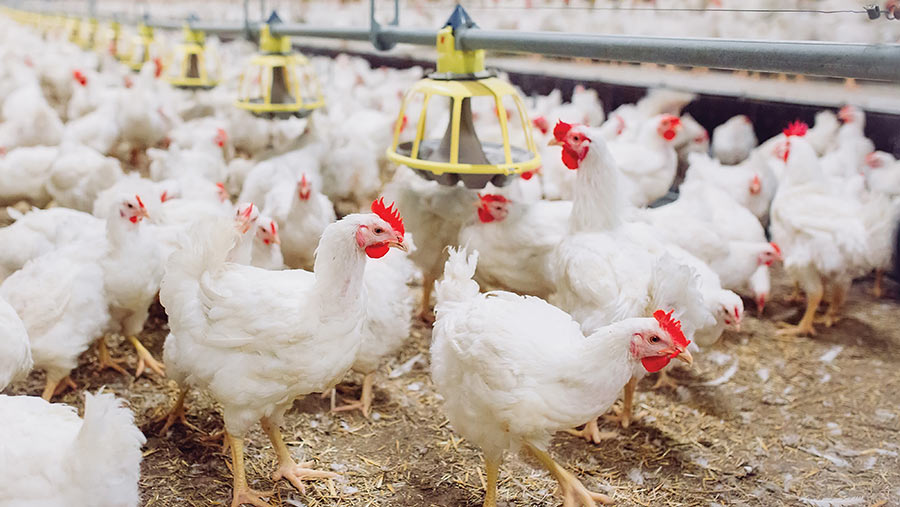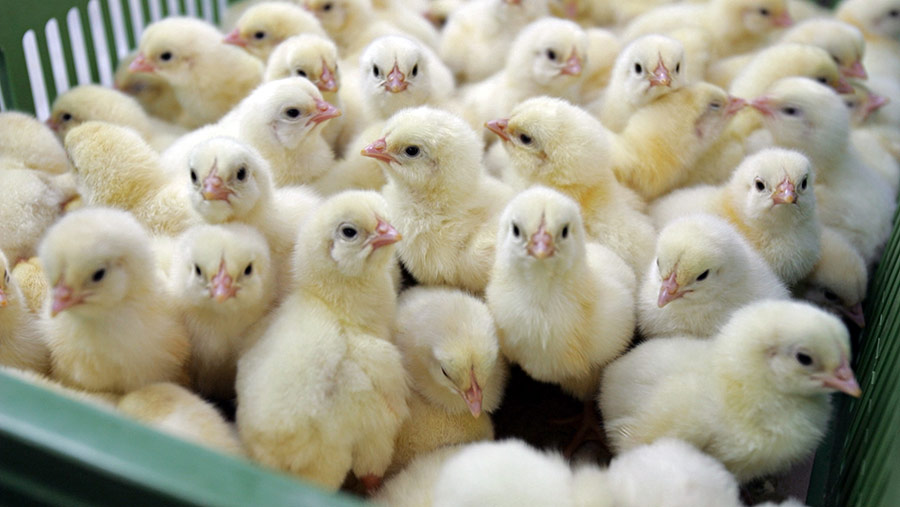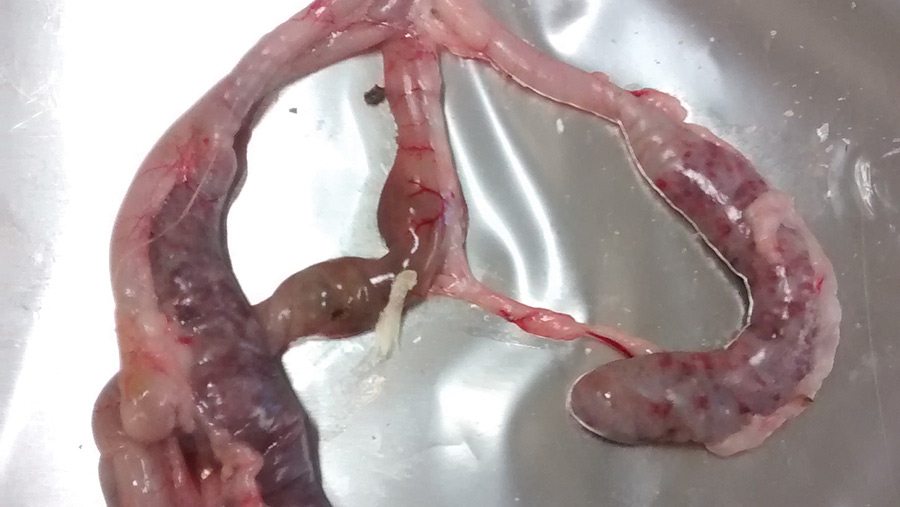Coccidiosis in broilers – what role will new vaccines play?
 © Davit85/Adobe Stock
© Davit85/Adobe Stock Research is under way at the Royal Veterinary College (RVC) to develop cheaper vaccines that could be used more widely against coccidiosis in broilers.
Current vaccines for the disease – caused by the Eimeria parasite – work well but are relatively expensive. And because the vaccines have to be produced in live chickens, it is difficult to scale up production.
“There are also three new emerging species of Eimeria that can escape current vaccines,” says Professor Damer Blake at the RVC.
See also: How to detect and treat coccidiosis in broilers
His research group is working to develop subunit vaccines, which contain purified parts of the pathogen rather than the whole of it.
These could be grown in a yeast or bacterial delivery system, removing the need to use live chickens.
“We have got to the stage where a subunit vaccine can provide good protection against low-level infection,” he says.
“We’re now working to improve delivery to enhance the strength of protection where there are high infection levels.”
For decades, farmers have been using coccidiostats in feed to control the disease. Coccidiostats fall into two main groups: ionophores and synthetic chemicals.
Different protocols are used to prevent resistance to these medications.
For example, a producer may use one type for a whole broiler crop, whereas another may use different ones in starter, grower and finisher diets; the latter protocol helping to avoid resistance.
If a subunit vaccine could be developed, it would dramatically reduce coccidiostat use. Damer says: “Research into vaccines is becoming more important at the moment as there is a lot of pressure to reduce drug use in livestock. If we’re going to do that, we need alternatives.”
Eimeria is only one part of the gut health picture, though. Scientists are also looking at how probiotics and natural plant extracts can enhance overall gut balance.
“There is a place for both these and vaccines, working in a complementary way,” says Damer.
What causes coccidiosis?
Coccidiosis can be spread by litter beetle, dust, wild birds and contaminated equipment. Once birds are infected, they will shed oocysts (eggs).
Poultry Health Services vet Elliott Boyd says: “We cannot do much. Chickens like to peck the ground so coccidial oocysts will always get in.”
Once ingested, oocysts replicate in the gut and damage the bird’s intestinal mucosa.
“The oocycts are ubiquitous in the poultry environment. They are very hardy and resistant to many disinfectants,” says Elliott.
They are also resistant to hot and cold temperatures and can survive in the soil for weeks. They prefer damp conditions for sporulation.
Ingesting small numbers of oocysts can lead to a mild infection. But if broilers ingest high numbers, disease can be quite severe.
“They can get the disease from litter pecking, contaminated feed, and dirty water drinkers. Keeping it at low levels is a challenge,” says Elliott.
Coccidial-specific disinfectants should be used at turnaround time, but it is almost impossible to get rid of oocytes. The goal is not to have a completely clean shed, though, he says.
“A low level of infection of young birds gives them immunity later in life.”
Biosecurity is important in keeping infection rates low, and producers should take care not to wear the same boots on different units.

© Colos/Adobe Stock
How current vaccines work
“We give a small dose of oocysts to produce immunity,” explains Elliott. “There are several Eimeria strains specific to chickens, and generally a number of these are included in each vaccine.”
The live vaccines contain low numbers of oocysts and strains with a lower reproductive potential and reduced virulence. Vaccinated birds will then develop their own immunity.
Vaccination is carried out while in the hatchery or at a day old. Compared with the economic losses it is worthwhile. However, most producers continue to use coccidiostats.
“A lot of flocks don’t have big problems and use coccidiostats because they are cheaper than vaccines,” Elliott says. “Or their attitude is: ‘If it isn’t broke, don’t fix it’.
“If people are having problems with strains resistant to coccidiostats, then vaccination is a strong tool to decrease the resistant populations and repopulate the farm with sensitive vaccine strains.
“Therefore, if resistance to coccidiostats continues to increase in the future, vaccines could become more popular.”
Signs of the disease in a flock
Coccidiosis is one of the most common diseases diagnosed in practice, according to Poultry Health Services vet Elliott Boyd, although symptoms are often subclinical.
“Signs are reduced growth and poorer feed conversion efficiency. For most birds it will be present at this low level, but for some, which have compromised immunity or encounter a large dose of Eimeria, disease can be severe, leading to high mortality,” he says.
Mortality is generally rare, though. More commonly, broilers suffer ill thrift, which impacts their European Production Efficiency Factor (EPEF), he explains.
“If the chicken has a grumbling, low-grade illness, it is diverting its energy into fighting infection and not into growing and producing meat.”
The Morbidity Scoring Scale can be used to help producers assess the severity of coccidiosis in the flock:
- 0 Normal behaviour
- 1 Ruffled feathers (especially on the neck) and squealing
- 2 Prostration or apathy, squealing
- 3 Worse condition and no noise
- 4 Ruffled feathers, curling up in a ball, dropping wings, staggering, eyes closed or half-closed
A faecal flotation test – which forces the parasite to float to the surface of a stool/liquid mixture – can also help to confirm diagnosis.
Finally, a post-mortem will show characteristic lesions in the intestine which, when scraped and examined under a microscope, can reveal oocysts.

Eimeria lesions seen during post-mortem © Poultry Health Services
The rising cost of coccidiosis
In 1999, researcher Ray Williams, at what was then pharmaceutical company Schering Plough, published one of the most comprehensive estimates for the cost of coccidiosis in the UK chicken flock, indicating a total loss of more than £38m, based on the cost of prevention, treatment and losses in 1995.
In 2020, a veterinary research paper, Recalculating the Cost of Coccidiosis in Chickens, updated the Williams model using data from industry representatives including vets, farmers, production and health experts.
It estimated the cost in 2016 to be £99.2m (range £73m to £125.5m).
The same study estimated the global cost to be £10bn, making coccidiosis arguably the most economically important disease in broilers, costing 16p for each chicken produced.
